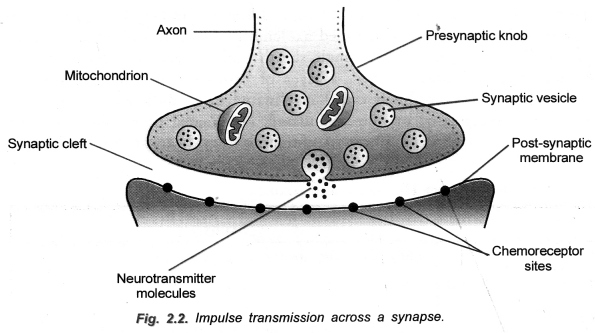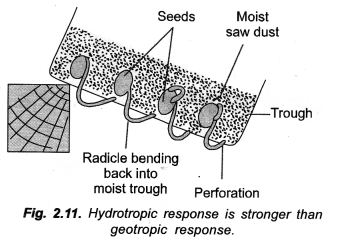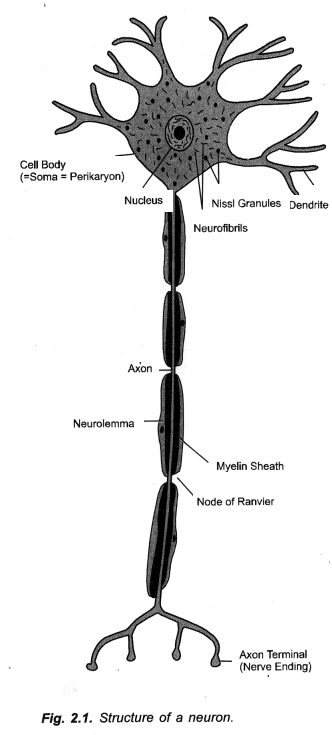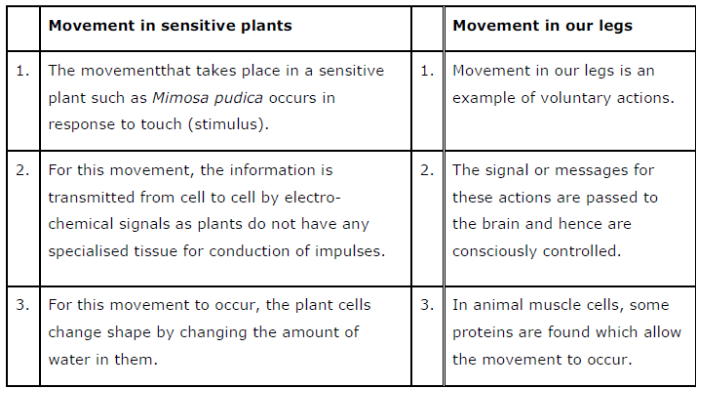In this chapter 7 Control and Coordination, students will learn about the nervous system of animals, reflex actions, the human brain, how tissues are protected and how nervous tissues cause action, coordination in plants, hormones in animals.
NCERT Solutions for Class 10 Science Chapter 7 Control and Coordination
These Solutions are part of NCERT Solutions for Class 10 Science. Here we have given NCERT Solutions for Class 10 Science Chapter 7 Control and Coordination. Learn Insta provides you the Free PDF download of NCERT Solutions for Class 10 Science (Biology) Chapter 7 – Control and Coordination solved by Expert Teachers as per NCERT (CBSE) Book guidelines. All Chapter 7 – Control and Coordination Exercise Questions with Solutions to help you to revise complete Syllabus and Score More marks.
NCERT Questions
In Text Questions
Question 1.
What is the difference between reflex action and walking ?
Answer:
| Reflex | Walking/Voluntary |
| 1. Origin. Reflex action is inborn and present in an individual right from birth.
2. Control. It is automatic. An individual cannot control it. 3. Intensity. It cannot be changed. 4. Value. It has survival and protective value. |
It is acquired through learning.
It is under control of the will or brain. It can be changed. It has various functions, generally other than survival and protection. |
More Resources
- NCERT Solutions for Class 10 Science
- NCERT Exemplar Solutions for Class 10 Science
- HOTS Questions for Class 10 Science
- Value Based Questions in Science for Class 10
- Previous Year Question Papers for CBSE Class 10 Science
Question 2.
What happens at the synapse between two neurons ?
Answer:

At synapse, axon terminal is expanded to form presynaptic knob. The dendrite terminal that lies close to it is slightly broadened and depreseed to form post-synaptic depression. A fluid filled narrow space, called synaptic cleft, occurs between the two. When an impulse reaches the presynaptic knob, it stimulates the release of neurotransmitter into synaptic cleft. Neurotransmitter comes in contact with chemoreceptor sites of the membrane of postsynaptic depression. This generates an electrochemical signal or impulse in the dendrite part of second neuron.
Question 3.
Which part of brain maintains posture and equilibrium of the body ?
Answer:
Cerebellum.
Question 4.
How do we detect the smell of an agarbatti (incense stick) ?
Answer:
Burning of an agarbatti emits smoke having very large number of odorant molecules. They enter the nose along with inhaled air. The odorant molecules are trapped in mucus present over olfactory epithelium. Olfactory receptor cells have a number of non-motile olfactory hair containing special protein molecules. Contact between the two forms cyclic AMP that generates an impulse in the receptor cells. Nerve fibres coming out of the cells carry the information to olfactory bulbs which transmit the same to temporal lobes of cerebrum for interpretation.
Question 5.
What is the role of brain in reflex action ? (CCE 2010, 2015)
Answer:
It functions as a relay centre for transferring impulse from sensory to motor neurons in several reflex actions called cerebral reflexes, e.g, closure of eyes exposed to flash of light, salivation at the sight or smell of food. In spinal reflexes it acts as information collecting and evaluation centre without any direct involvement in reflex action.
Question 6.
What are plantohormones ?
Answer:
Phytohormones are chemical substances other than nutrients produced naturally in plants which regulate growth, development, differentiation and a number of physiological processes, e.g., auxin, gibberellins, abscisic acid, cytokinins.
Question 7.
How is movement of leaves of Sensitive Plant different from movement of shoot towards light ? (CCE 2015)
Answer:
Movement in the leaves of Sensitive Plant (Mimosa pudica) is haptonastic movement which occurs due to turgor changes in the cells of pulvinules and pulvinus. Movement of a shoot towards light is. phototropic movement that is caused by differential growth.
Question 8.
Give an example of a plant hormone that promotes growth ?
Answer:
Indole 3-acetic acid or IAA (auxin).
Question 9.
How do auxins promote the growth of a tendril around a support ? (CCE 2015)
Answer:
Less auxin occurs on the side of contact as compared to the free side. More growth occurs on the free side.
As a result of more growth on the free side, the tendril coils around the support.
Question 10.
Design an experiment to demonstrate hydrotropism. (CBSE 2010, CCE 2011)
Answer:
Apparatus: Trough with perforated base, saw dust, water, seeds of Pea/Gram, wooden support.
Procedure: Take a trough with perforated base. Fill it with saw dust. Moisten the same. Sow several seeds of Pea or Gram. Place the trough in slanting position by means of a wooden block. Keep the saw dust moist by sprinkling water at intervals. Observe after 2-3 days.
Observation: As the radicles come out of the seeds, they are seen to move towards the perforations. They come out of the pores and hang downwardly for some time under the influence of gravity. However, after some growth they bend back and enter the perforations to reach moist saw dust in complete disregard of gravity (Fig. 2.11).

Inference: Bending of radicles back into moist saw dust is hydrotropic movement. It occurs despite being against the force of gravity.
Question 11.
How does chemical coordination take place in animals ?
Answer:
In animals, chemical coordination is achieved through the agency of hormones which function as chemical messengers or informational molecules. Hormones are secreted by ductless glands in response to specific conditions or nervous stimulation. Timing and amount of a hormone released are regulated by feed-back mechanism. After a meal, sugar level of blood rises. It is detected by pancreas. Pancreas responds by producing hormone insulin from (3-cells of islets of Langerhans. Insulin causes glucose to be absorbed by all cells as well as get stored in liver and muscles in the form of glycogen. As the level of glucose falls in blood, insulin secretion is reduced.
Question 12.
Why is the use of iodised salt advisable ? (CCE 2011, 2015)
Answer:
Iodine is essential for synthesis of hormone thyroxine in thyroid gland. Thyroxine controls basal metabolic rate, physical activity, body temperature, heart beat, mental, physical and sexual development besides regulating carbohydrate, protein and fat metabolism. Deficiency of thyroxine disturbs metabolic, physical and mental activities besides causing disorders of simple goitre, cretinism and myxedema. Therefore, it is always advisable ^ to take iodised salt so that there is no deficiency of iodine.
Question 13.
How does our body respond when adrenaline is secreted into blood ?
Answer:
Adrenaline/emergency hormone/triple F hormone
- Reduces blood supply to peripheral blood vessels and gastrointestinal tract,
- More blood flows to skeletal and heart muscles.
- Increases breathing and gives more oxygen to muscles,
- Increases heart rate,
- Mobilises more glucose to muscles for higher activity.
Question 14.
Why are some patients of diabetes treated by giving injections of insulin ?
Answer:
Diabetes mellitus is of two types, insulin dependent and insulin independent. In insulin dependent diabetes, pancreas is unable to produce required quantity of insulin. As a result blood sugar continues to rise and part of sugar is excreted through urine resulting in diabetes. This is kept under check by regular injection of insulin. Availability of insulin will help the cells to take up glucose while liver and muscles are induced to store excess of glucose as glycogen.
NCERT Chapter End Exercises
Question 1.
Which of the following is a plant hormone ?
(A) Insulin
(B) Thyroxine
(C) Oestrogen
(D) Cytokinin.
Answer:
(D).
Question 2.
The gap between two neurons is called
(A) Dendrite
(B) Synapse
(C) Axon
(D) Impulse.
Answer:
(B).
Question 3.
The brain is responsible for
(A) Thinking
(B) Regulating the heart beat
(C) Balancing
(D) All the above.
Answer:
(D).
Question 4.
What is the function of receptors in our body ? Think of situation where receptors do not work properly. What problems are likely to arise ? (CCE 2011)
Answer:
Receptors are specialised cells, tissues, organs and nerve endings which are able to pick up specific stimuli, e.g., photoreceptors, gustatoreceptors, thermoreceptors, photoreceptors, statoreceptors, tangoreceptors, pain and pressure receptors. Receptors provide sensory input about external and internal environment. Without them, an animal will not able to observe, handle and taste food. It will not be aware of an approaching enemy. The animal may not be able to correct its position and fall down repeatedly if its statoreceptors are damaged. Therefore, the animal will not be able to perform the activities connected with the defective receptors.
Question 5.
Draw the structure of a neuron and explain its functions. (CCE 2011, 2013)
Answer:

Functions:
- Dendrites. Picking up sensations and transmitting the same to cell body.
- Cell Body,
- Sustaining structure and function of dendrites and axon,
- Functioning as passage¬way for transmission of sensation or impulse to axon.
- Axon. Carrying impulse to another neuron, muscle, gland and organ. A single impulse can be transmitted to several structures with the help of axon terminals.
Mechanism of Impulse Transmission:
Impulse is a self propagated electrical current that travels from one end to another of a neuron for the passage of a message.
The pathway is stimulus ——— >dendrite ——- > cell body ——- > axon——– > axon terminal ——– > passage of stimulus.
A stimulus received by a neuron travels through it in the form of an electrical disturbance. During rest the outer surface of a neuron is positively charged while the interior has negative charge. Stimulus causes opening of ion channels which makes the outer surface negatively charged while the interior becomes positively charged. This creates the impulse which moves forward. The posterior region returns to the condition of rest. At the end of the neuron, the impulse is passed on to the next neuron, an organ, muscle or gland in the form of a neurotransmitter. Neurotransmitter is a chemical secreted by axon terminal for transmission of impulse to the next neuron, muscle, gland or organ, e.g., acetylcholine, noradraneline, glutamic acid.
Question 6.
How does phototropism occur in plants ?
Answer:
It is directional growth movement of curvature which occurs in response to unidirectional exposure to light. The region of photoperception is sho.ot apex while the region of response is in the area of elongation. The light effective in phototropic response is blue light. The photoreceptor is a flavoprotein called phototropin. Leaves are essential for producing the response.
Stems generally bend towards the direction of light. They are positively phototropic. Leaves generally come to lie at right angles to light. They are diaphototropic. Roots are either neutral (non-phototropic) or negatively phototropic. Positively phototropic heads of Sunflower perform solar tracking as they move from east to west along the direction of sun.
Phototropic movement is generally caused by increased auxin on the dark side and lesser auxin on the illuminated side. It causes more growth on the dark side of stem causing it to bend towards the source of light. The opposite happens in root where less auxin stimulates growth while higher auxin inhibits growth.
In the plant growing in the open, sunlight is received from above. Auxin diffuses equally on all sides so that the stem does not bend but grows straight vertically.
Question 7.
Which signals will get disrupted in case of spinal cord injury ?
Answer:
- Sensory impulses from the area innervated by injured portion,
- Transmission of motor impulses through the injured portion,
- Reflex action in the area of injury. Sensations and movements are restricted.
Question 8.
How does chemical coordination occur in plants ?
Answer:
Plants produce a number of hormones which control and coordinate their functioning. Amount of hormone depends upon the environment and other stimuli. Its effect is also regulated by its antagonistic * hormone, e.g., auxin and abscisic acid. The effect is enhanced by synergic presence of another hormone, e.g., auxin and gibberellin.
Question 9.
What is the need for a system of control and coordination in an organism ?
Answer:
The body of a multicellular organism consists of a number of components and sub-components, each specialised to perform a particular fonction. However, all the components are not required to fonction all the time at the same speed. A system of controls is required to allow them to perform or not to perform, slow down or speed up their working. Further, most activities require the simultaneous or sequential functioning of a number of parts, stopping some and stimulating others. During feeding, eyes locate the food, nose registers its smell, hands pick up the food and take it to mouth, mouth opens to receive the food, teeth and muscles take part in its mastication and saliva moistens it. Tongue perceives its taste. It moves the food below the teeth. Later it pushes the crushed food into pharynx. All this is possible only through a system of coordination.
Question 10.
How are involuntary actions and reflex actions different from each other ?
Answer:
Refex actions are involuntary in nature which are carried out to meet emergencies. However, all involuntary actions are not reflex actions. They fulfill critical life processes, e.g., circulation of blood, movement of food in food pipe.
Question 11.
Compare and contrast nervous and hormonal mechanisms for control and coordination in animals.
Answer:
Nervous system controls and coordinates many body functions as it has a well spread network of neurons. Messages travel very fast, in the form of electrical impulses. However, it has limitations,
- Nerve impulses do not reach each and every cell of the body,
- The effect of nerve impulse is of short duration,
- Nerve impulses cannot pass continuously.
A small gap is required between two impulses. These short-comings are overcome in endocrine system. Here, the stimulated glandular cells secrete chemicals that diffuse throughout the body. Cells have receptors for picking up chemical information. The information can pass persistendy. The passage of information is, of course, slower. It, however, influences all the cells of the target. A multiple effect can also be produced. Adrenaline reduces blood supply to skin and digestive system but increases the same to skeletal or voluntary muscles. There is increase in breathing rate and heart beat. The body becomes ready to deal with an emergency. Further, endocrine system controls and coordinates many processes of the body where nervous system has no role, e.g., cell permeability, cell division, cell growth, cell differentiation, development of sex organs, secondary sex characters and several other activities. Any discrepancy can lead to a disorder, e.g, dwarfism and gigantism, hypothyroidism (simple goitre, cretinism, myxedema), hyperthyroidism (exophthalmia).
Question 12.
What is the difference between the manner in which movement in Sensitive Plant and movement in our legs takes places ?
Answer:

Selection Type Questions
Alternate Response Type Questions
(True/False, Right(√)/Wrong (x), Yes/No)
Question 1.
Fore brain is centre of intelligence, control of movements, hearing, smell and sight.
Question 2.
Chewing cud is a movement of growth.
Question 3.
Immediate response to stimulus is shown by Mimosa pudica.
Question 4.
Rise in sugar level in blood stops secretion of insulin by pancreas.
Question 5.
Control and coordination are functions of nervous and endocrine systems.
Question 6.
Stems are positively geotropic while roots are negatively geotropic.
Question 7.
Major part of taste is smell.
Question 8.
I withdrew my hand back from hot plate reflexly.
Matching Type Questions
Question 9.
Match the articles in columns I and II (single matching) :
|
Column I |
Column II |
|
(a) Cell growth (b) Wilting (c) Emergency (d) Electrical impulses |
(i) Abscisic acid (ii) Nerve conduction (iii) Adrenaline (iv) Auxin. |
Question 10.
Match the contents of columns I, II and III (double matching) :
| Column I | Column II | Column III |
|
(a) Thyroid (b) Shoot tip (c) Receptor (d) Motor end plate |
(i) Reflex arc
(ii) Neuromuscular junction (iii) Thyroxine (iv) Auxin |
p. Iodine q. Acetylcholine r. Apical dominance s. Effector |
Question 11.
Name the control — voluntary (V), involuntary (I) and endocrine (E) in the following (Key or Check list Items) :
Action Control
(i) Peristalsis ………………..
(ii) Lifting of arms ……………….
(iii) Growth ……………….
(iv) BMR ………………..
Question 12.
Match each stimulus with appropriate response :
| Hormone | Dwarfism (A) |
Cretinism (B) |
Pregnancy (C) |
Calcium level (D) | Dilute urine (E) | Mammary glands (F) |
|
(i) Thyroxine (ii) Growth hormone (iii) Parathormone (iv) Prolactin (v) Vasopressin (vi) Progesterone |
Fill In the Blanks
Question 13. A ………………… mechanism regulates the action of hormones.
Question 14. An axon terminal passes the electrical stimulus to a dendrite of next neuron through …………………. reaction.
Question 15. Reflex arc formed in spinal cord also sends information input to ………………… .
Question 16. ……………………….. coordinates the activity of picking up pencil for writing.
Question 17. Positive geotropism of root is due to greater growth on ……………………… side as compared to ………………… side.
Answers:

NCERT Solutions for Class 10 Science Chapter 7 – Control and Coordination
Hope given NCERT Solutions for Class 10 Science Chapter 7 are helpful to complete your science homework.
If you have any doubts, please comment below. Learn Insta try to provide online science tutoring for you.